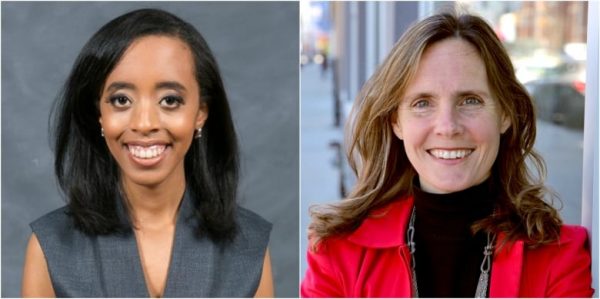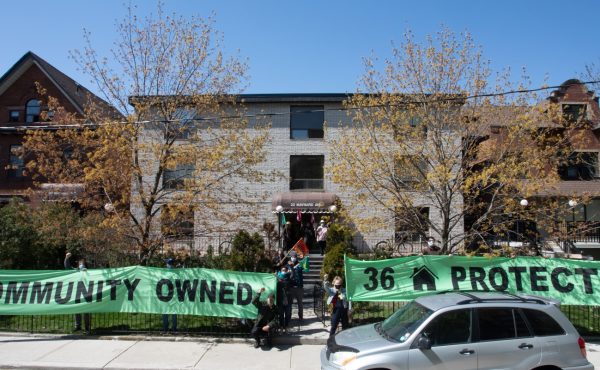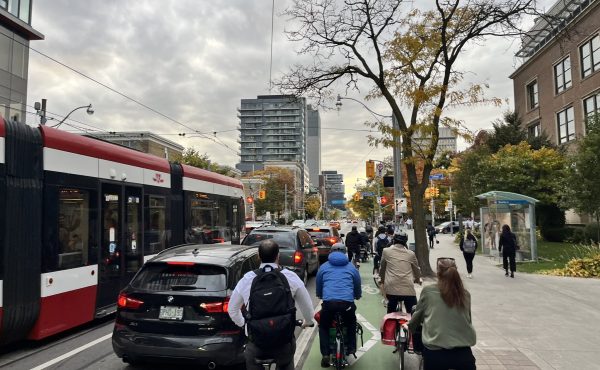All of a sudden, Toronto’s spectral mayoral race has turned into a fringe festival.
Seemingly out of the blue (though not actually), candidates Sarah Climenhaga, a community activist, and Saron Gebresellassi, a lawyer, have captured at least the media’s attention during three mayoral debates, with strongly articulated positions on issues such as safe streets and the high cost of transit.
In particular, Gebresellassi’s provocative call for free transit has injected frisson into the debates, prompting some commentary and subtly serving as a reminder that Mayor John Tory’s 2014 election pledge, to make transit free for children under 12 ostensibly in the name of equity, didn’t make much of difference to lower income families living in inner suburban areas like Weston, where Gebresellassi currently runs her law office.
Then, waaaaaaaaaaay over at the other end of the political spectrum, we have the hallucinatory side show being whipped up by mayoral candidate Faith Goldy and her band of white rights warriors. Ever since she sidled up to Doug Ford at Ford Fest last Saturday, Goldy has, with clear tactical intent, maneuvered herself into the media viewfinder, prompting (in this order) questions in the Ontario legislature, a succession of defensive and then mealy-mouthed responses from Ford & co., TV coverage of her micro-demonstrations, columnizing in the Toronto Star and the Globe and Mail, and a self-manufactured sidebar drama about how CP24 has refused to run her ads.
Canadaland has also chimed in with a detailed advice piece for scribes venturing for the first time into the hate house of mirrors that is Goldyland.
Is there something wrong with this picture?
I don’t have an especially intelligent answer, but something about the emerging dynamic feels wrong, particularly in light of the massive problems that await the next council thanks to the one-two punch of partisan meddling and looming financial downloading that will define Ford’s term.
On the positive side, there’s no question that both Climenhaga and Gebresellassi have injected energy and drama into a sleepy contest. While the likelihood that either will become mayor is exceedingly low – they are both polling between 1 and 2%, according to a new Mainstreet survey – it’s possible to regard these kinds of candidates as interlocutors in what’s meant, at least in theory, to be a city-wide conversation about Toronto’s immediate future. (Goldy’s polling numbers are in the same range.)
Yet if we accept the notion that fringe candidates are in these races in order to enliven the debate and move it beyond the message tracks of the mainstream candidates – more on this in a moment – we must also concede that the process for surfacing their views is arbitrary and flawed.
Climenhaga and Gebresellassi, as well as marketing professional Gautam Nath, ended up on the stage for the first mayoral debate, hosted Monday by Arts Vote Toronto, ostensibly because they filled out the organization’s candidate questionnaires and were deemed to pass muster. All acquitted themselves well.
But Tory’s pre-condition for participating in debates is that they be open to other candidates besides Jennifer Keesmaat (except those advocating hate). So the reality is that we’re only now hearing from Climenhaga and Gebresellassi because of a tactical calculation by the mayor to avoid one-on-one debates with the only candidate who might unseat him.
In other words, right result (sort of), but for all the wrong reasons.
There’s also a deeply regrettable unintended consequence: the fact that some fringe candidates are allowed to be on stage gives Goldy an opening to cry fowl: `If them, why not me?’ And she, of course, is taking full advantage to make a mockery of what turns out to be a problematically opaque process.
If we accept the general proposition that mayoral or leaders debates function as critical junctures in the life of every election, these events certainly shouldn’t be vulnerable to any kind of manipulation.
More generally, the murky process of how leading or visible mayoral candidates are anointed – I’ve used the passive construction here deliberately – is even more glaring in this election than previous ones.
For as long as I can remember, the City of Toronto has maintained a low bar for those aspiring to participate in mayoral races – a quaintly egalitarian idea that produced, in the past, plenty of cranks, entertaining joke candidates like Enza the Supermodel, and also a few complicated figures, like the late Tooker Gomberg, a cycling advocate who entered the 2000 race, against Mel Lastman, to advocate for a Bloor bike lane.
Gomberg died tragically by suicide in 2004 but there’s no question his candidacy sparked the long and difficult dialogue that culminated with the construction of the Bloor Street bike lane a few years ago.
The 2000 race was barely an election. Lastman, in trouble over idiotic comments about the city’s 2008 Olympic bid, spent most of the campaign hiding from the media, which meant that there was virtually no public debating.
The 2003 election was contested by four candidates with significant political careers (David Miller, Barbara Hall, Tom Jakobek, John Nunziata) and also featured a huge number of debates, thanks largely to a tactical decision by David Miller’s advisors to encourage such events as an inexpensive way of raising his profile.
That contest, of course, also included an individual not especially well known outside Toronto establishment and Progressive Conservative circles: John Tory. I think it’s safe to say that Tory ended up in the debates and, ultimately, as the second place finisher, because he wasn’t entering as a fringe candidate, but rather as an aspiring political figure who came to the race equipped with financial resources as well as the heft of a Liberal/Tory campaign team. He’s not the first, nor will he be the last, person to run for office to create a profile that can be leveraged later on. It’s a perfectly reasonable approach to public life.
There was, of course, no pre-vetting process, like a leadership race, and Tory, in 2003, was competing for both centrist and conservative votes against Hall, Nunziata and Jakobek. But going in, he had his organizational ducks in a row.
In the years since, other non-political figures have turned up among the ranks of the `official’ or on-the-stage candidates, notably former Liberal fundraiser Rocco Rossi and Sarah Thomson.
Rossi came to be considered a serious candidate mostly because he had a fantastic Rolodex of contacts in the world of political operatives, experience as organizer (he was one of Tory’s campaign managers in 2003) and good contacts in the press. Thompson essentially shamed her way into the 2010 race by pointing out that the mayoral debates would feature only men.
Coming from different directions, both flamed out. Rossi thought he could win. I have no idea what motivated Thomson, but those of us who covered her campaign (and subsequent activities) couldn’t help but notice a great deal of attention-seeking behaviour that was rewarded for all the wrong reasons.
In this race, Goldy’s stunt campaign has upped the ante, raising fears that, in this grim revanchist moment we’re in, she will whip up a Trump-ian vicious circle: calculated outrageousness sparking media coverage, which in turn attracts or surfaces new supporters, with fabricated momentum begetting the real thing. The depressing reality is that if Goldy’s antics yield 4 to 5% of the final votes cast, that means 30,000 or 40,000 Torontonians will have backed someone with a white supremacist agenda.
I’d argue, however, that Goldy’s presence exposes the structural failure inherent in the random way in which Toronto conducts its mayoral races. After all, there are all sorts of fringe parties at the federal and provincial levels whose leaders or spokesperson don’t get a spot on the stage in leaders debates.
It’s true the Greens have long endured the exclusion problem, although that situation is shifting as the party builds its base and gains seats around the country. Those wins, and the recognition that has followed, only occurred because the members of the Greens have invested the time and energy to consolidate themselves as a national party that aspires to influence policy and represent constituents. A generation ago, Preston Manning’s Reform movement faced the same challenge, and its followers had to invest the sweat equity in building the party before earning official status.
Do we need a similar approach with mayoral candidates? Obviously, because Toronto council doesn’t have an official party system, there’s no formal mechanism for vetting candidates.
Should there be?
In considering the question (and I don’t have a solution), I find myself looking at this question structurally. The mayor of Toronto is elected directly by more voters than any other politician in the country. She or he presides over a council responsible for overseeing a $13 billion-a-year municipality — an institution considerably larger than several provincial governments. The mayor is formally responsible for inter-governmental relations, and, along with the rest of council, has a solemn duty to protect the economic vitality, social well-being and quality of life in a city that attracts 50,000 new residents per year and generates almost 10% of the entire country’s gross domestic product.
Given all that, remind me again why we are so invested in a system that allows its elections to be hijacked by anyone with $100 and an ID card?






5 comments
Great article. I think that there is one big issue that needs to be addressed when we talk about the suitability of who should be able to run to take on the civic responsibilities that you mention in your second to final paragraph. Whether a candidate is a viable option to be a city leader is different than whether they are in a position to run a good campaign. It is the latter that deems a mayoral candidate to be fringe, not my qualificiations or ability. When it comes to campaigning or to public profile, I’m not in the same league as either Jennifer Keesmaat or John Tory (or for that matter Faith Goldy or Blayne Lastman – who would have gotten lots of attention had he run). But I think we confuse the two both within and outside the media.
Is any one individual really qualified to be run this city? Was Rob Ford or David Miller or Mel Lastman? Some will say yes for each of these, some will say no. A city is run by a huge team of staff. In our democracy a leader needs only to be a citizen and not previously convicted of election offenses. Any qualifications beyond that are, in theory, a matter for voters to decide. If we want to impose further restrictions on who should run, we should do that openly, so that media coverage can concentrate fairly on those who meet those qualifications, rather than decisions behind the scenes on who is viable. The public outside of politically engaged circles only knows who is running through the information the media gives them. That’s a responsibility that I’m not sure the media is taking its role in seriously enough.
Unfortunately, the mayoral election is a winner-take-all with no second run-off vote. The runner-up doesn’t get anything, nor does anyone trailing. Given that there is an incumbent, it doesn’t make sense to consider more than one anyone-but-the-incumbent candidate. Keesmaat has already captured that mantle.
I appreciate that there are a lot of people with great ideas for the city, but Tory’s only serious opponent in this election is Keesmaat simply because that’s how our first-past-the-post system works. I think Keesmaat has an excellent platform for transit, affordable housing, and standing up for Toronto’s interests.
Usually, I have a high confidence in what’s written here being correct, but a couple of big errors. Yes, Tooker Gomberg ran against Mr. Lastman, but no, he had a fairly full-spectrum platform for this greenhouse century. The TaketheTooker Bloor/Danforth bikeway idea was created shortly after his death to provide living legacy, and was not part of his campaign. Also, what’s been put in place on Bloor in the Annex ONLY, is about a third of what was agreed to be studied (again) about a decade ago, and we still don’t have that bit of Bloor St. E. between Sherbourne and Church remotely safe for bikes, though it was in the 2001 Bike Plan for painted bike lanes costing $25,000. Given how the 1992 study that gave Bloor/Danforth the #1 for east-west biking was motivated by a climate goal, and how pathetically little we’ve done, when a bikeway is cheap subway relief, yup, easy to see why climate change rolls on.
Most other large cities would see the wisdom of slightly squeezing cars a little bit atop a subway; I think you should have been aware of the shortfalls/errors in this copy.
In answer to your question: Because that’s democracy. It doesn’t matter if you agree or not. It’s the process the majority have decided is best and most likely to allow competence and ability (past and present) to succeed.
Perhaps, in addition to the qualification of “$100 and an ID card”, a test could be added to the eligibility qualifications for running for mayor. Requiring candidates to pass a brief test beforehand that determines whether candidates have the basic understanding of how municipal government operates would eliminate a lot of the spurious attention seeking candidates, I figure.